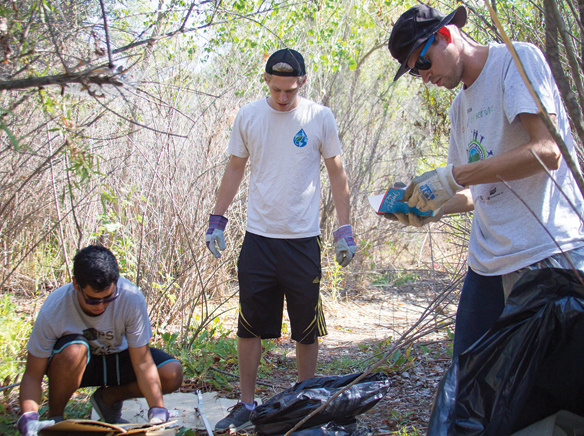Walking the trails of Santee’s segment of the San Diego River, once viewed as the prefect blend of urban and environmental life, began to overrun with waste. Members of San Diego River Park Foundation decided enough was enough.
Walking the trails of Santee’s segment of the San Diego River, once viewed as the prefect blend of urban and environmental life, began to overrun with waste. Members of San Diego River Park Foundation decided enough was enough.
Scores of volunteers gathered Sept. 14 at the Town Center Parkway in Santee to do their part in keeping San Diego’s rivers and ocean clean. San Diego River Park Foundation in partnership with the U.S. Department of Interior Water Reclamation Bureau organized their “Clean and Green” troops in order to combat the littering and illegal dumping in one of San Diego’s most prized natural wildlife sanctuaries.
Jack Simes, area-planning officer with the Water Reclamation Bureau identified a major source of pollution of the Santee watershed. He said unintended littering, ‘blow trash’ as its called within environmental circles, is the waste that leaves vehicles and properties, blown by the wind and ends up embedding itself in the environment.
“We have a two fold challenge,” said Simes. “getting it cleaned up and preventing this litter from entering the environment in the first place.”
Teams of volunteers braved the lush foliage
Shannon Quigley-Raymond, program coordinator for San Diego River Park Foundation, said their bi-annual sweeps for litter have netted considerable gains in reclaiming the watershed from its polluted past, back to a clean natural habitat for the red-tailed hawks, egrets and gray foxes that call it home.
“Just this season alone, we’re at the 40 percent reduction in trash removed from San Diego’s water sources compared to our average,” said Quigley-Raymond. “Usually, we remove about 70,000 pounds of garbage from the water shed every six months, now were down to about 40,000 pounds of trash, so it’s a huge difference. We see, not only from the reducing numbers but also visually from the river blitzes, that a majority of the trash is being removed from the water and it’s amazing what our volunteers have accomplished.”
River blitzes are a new strategy of the environmental coalition. Teams of trained surveyors and volunteers scour the 52 miles of river armed with digital cameras, GPS devices and field data sheets documenting instances of illegal dumping, nonnative plant species and preselected site conditions. The data is used to create up to date, informative river reports available to the community and other river environmental organizations. Quigley-Raymond said these efforts have been monumental in cleanup and restoration efforts.














